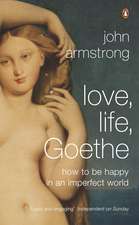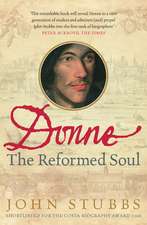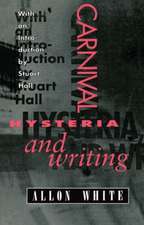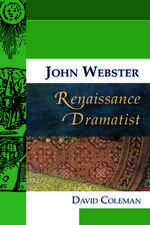Subject and Object in Renaissance Culture: Cambridge Studies in Renaissance Literature and Culture, cartea 8
Editat de Margreta de Grazia, Maureen Quilligan, Peter Stallybrassen Limba Engleză Hardback – 22 feb 1996
| Toate formatele și edițiile | Preț | Express |
|---|---|---|
| Paperback (1) | 428.41 lei 6-8 săpt. | |
| Cambridge University Press – 22 feb 1996 | 428.41 lei 6-8 săpt. | |
| Hardback (1) | 766.66 lei 6-8 săpt. | |
| Cambridge University Press – 22 feb 1996 | 766.66 lei 6-8 săpt. |
Din seria Cambridge Studies in Renaissance Literature and Culture
-
 Preț: 273.13 lei
Preț: 273.13 lei -
 Preț: 374.44 lei
Preț: 374.44 lei -
 Preț: 308.12 lei
Preț: 308.12 lei -
 Preț: 383.10 lei
Preț: 383.10 lei -
 Preț: 396.15 lei
Preț: 396.15 lei -
 Preț: 441.58 lei
Preț: 441.58 lei -
 Preț: 346.52 lei
Preț: 346.52 lei -
 Preț: 315.16 lei
Preț: 315.16 lei -
 Preț: 295.03 lei
Preț: 295.03 lei -
 Preț: 447.85 lei
Preț: 447.85 lei -
 Preț: 398.65 lei
Preț: 398.65 lei -
 Preț: 291.72 lei
Preț: 291.72 lei -
 Preț: 290.67 lei
Preț: 290.67 lei -
 Preț: 428.43 lei
Preț: 428.43 lei -
 Preț: 339.70 lei
Preț: 339.70 lei -
 Preț: 286.69 lei
Preț: 286.69 lei -
 Preț: 285.16 lei
Preț: 285.16 lei -
 Preț: 281.88 lei
Preț: 281.88 lei -
 Preț: 445.34 lei
Preț: 445.34 lei - 14%
 Preț: 820.69 lei
Preț: 820.69 lei -
 Preț: 443.11 lei
Preț: 443.11 lei -
 Preț: 286.30 lei
Preț: 286.30 lei -
 Preț: 379.25 lei
Preț: 379.25 lei -
 Preț: 299.17 lei
Preț: 299.17 lei -
 Preț: 282.10 lei
Preț: 282.10 lei -
 Preț: 395.17 lei
Preț: 395.17 lei -
 Preț: 310.45 lei
Preț: 310.45 lei -
 Preț: 424.67 lei
Preț: 424.67 lei
Preț: 766.66 lei
Preț vechi: 891.46 lei
-14% Nou
Puncte Express: 1150
Preț estimativ în valută:
146.70€ • 153.72$ • 121.27£
146.70€ • 153.72$ • 121.27£
Carte tipărită la comandă
Livrare economică 11-25 aprilie
Preluare comenzi: 021 569.72.76
Specificații
ISBN-13: 9780521454711
ISBN-10: 0521454719
Pagini: 420
Ilustrații: 47 b/w illus.
Dimensiuni: 160 x 237 x 28 mm
Greutate: 0.64 kg
Ediția:New.
Editura: Cambridge University Press
Colecția Cambridge University Press
Seria Cambridge Studies in Renaissance Literature and Culture
Locul publicării:Cambridge, United Kingdom
ISBN-10: 0521454719
Pagini: 420
Ilustrații: 47 b/w illus.
Dimensiuni: 160 x 237 x 28 mm
Greutate: 0.64 kg
Ediția:New.
Editura: Cambridge University Press
Colecția Cambridge University Press
Seria Cambridge Studies in Renaissance Literature and Culture
Locul publicării:Cambridge, United Kingdom
Cuprins
Introduction Margreta de Grazia, Maureen Quilligan and Peter Stallybrass; Part I. Priority of Objects: 1. The ideology of superfluous things: King Lear as period piece Margreta de Grazia; 2. Rude mechanicals Patricia Parker; 3. Spenser's domestic domain: poetry property and the Early Modern subject Louis A. Montrose; Part II. Materialisations: 4. Gendering the Crown Stephen Orgel; 5. The unauthored 1539 volume in which is printed the Hecatomphile, The Flowers of French Poetry and Other Soothing Things Nancy J. Vickers; 6. Dematerialisations: textile and textual properties in Ovid, Sandys, and Spenser Ann Rosalind Jones; Part III. Appropriations: 7. Freedom service and the trade in slaves: the problem of labour in Paradise Lost Maureen Quilligan; 8. Feathers and flies: Aphra Behn and the seventeenth-century trade in exotica Margaret W. Ferguson; 9. Unlearning the Aztec Cantares (Preliminaries to a postcolonial history) Gary Tomlinson; Part IV. Fetishisms: 10. Worn worlds: clothes and identity on the Renaissance stage Peter Stallybrass; 11. The Countess of Pembroke's literal translation Jonathan Goldberg; 12. Remnants of the sacred in early modern England Stephen Greenblatt; Part V. Objections: 13. The insincerity of women Marjorie Garber; 14. Desire is death Jonathan Dollimore; Index.
Recenzii
"This year's award for a must-read collection goes to Subject and Object in Renaissance Culture, with its knock-them-dead title. Confronted by such a work and its truly remarkable phalanx of academic stars, what reviewer could resist...they are as intelligent as they are well known." Studies in English Literature
"This focus on rethinking the relationship between subject and object is certainly worthwhile and novel. And the essays that follow include some dazzling explorations of this theme." Jvotsna G. Singh, Shakespeare Quarterly
"This focus on rethinking the relationship between subject and object is certainly worthwhile and novel. And the essays that follow include some dazzling explorations of this theme." Jvotsna G. Singh, Shakespeare Quarterly
Descriere
These essays by leading scholars offer a new focus on the Renaissance via objects rather than subjects.


















